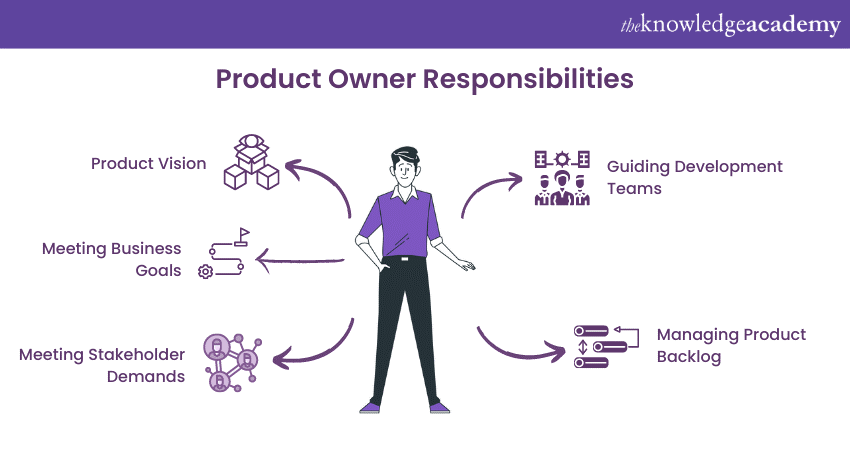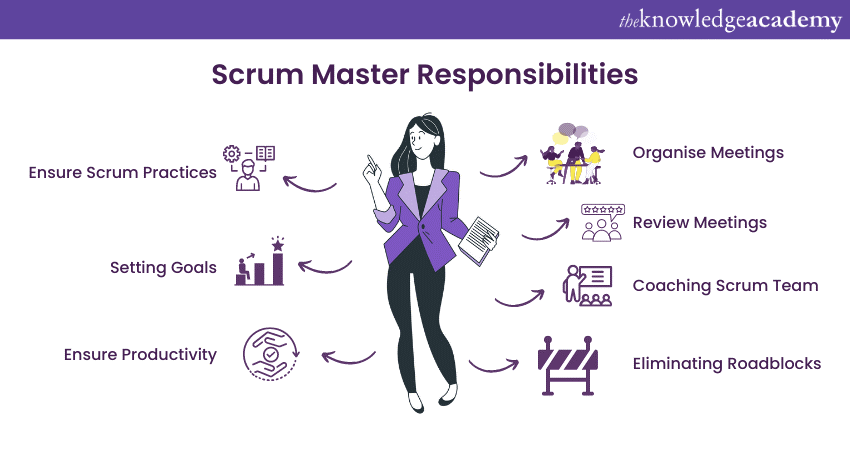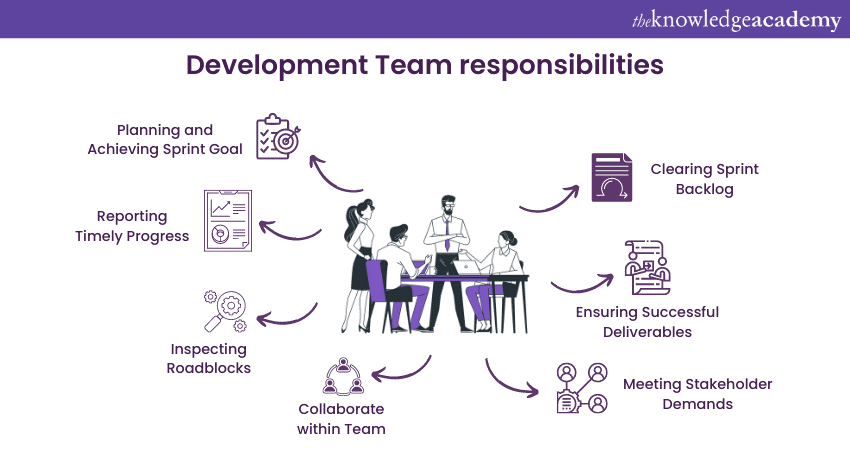We may not have the course you’re looking for. If you enquire or give us a call on +65 6929 8747 and speak to our training experts, we may still be able to help with your training requirements.
Training Outcomes Within Your Budget!
We ensure quality, budget-alignment, and timely delivery by our expert instructors.

Scrum is one of the most popular Agile frameworks that Development Teams follow to deliver work in sprints, also called Scrum Roles. It comprises of Product Owner, Scrum Master, and Development Team. Each role has a unique set of roles and responsibilities that make up for the project's overall success. In this blog you will find Scrum's major roles. Learn more about the various Scrum roles and their importance, which help make a great scrum team and various career paths that will boost your growth. Read More!
According to the State of Scrum 2017–2018 Survey, 78% of Scrum Teams are of size 5-9 members, 8% are 1-4 members, and 13% of Scrum teams consist of more than 10 members. If you are wondering what roles and responsibilities these Scrum team members perform, you are at the right place. Read this blog to learn more about the various Scrum Roles and their importance, which help make an excellent scrum team.
Table of Contents
1) What are the three Scrum Roles?
2) How to build a Scrum Team?
3) Who is a Product Owner?
4) Who is a Scrum Master?
5) What is a Development Team?
6) Conclusion
What are the three Scrum Roles?
The three Scrum Roles are Product Owner, Scrum Master, and Development Team. While there is only one Product Owner and one Scrum Master in a Scrum team, the Development Team consists of various members such as Software Developers, Designers, Testers, and Team Leads. Besides being in different Scrum roles and having different skillset, they try to achieve a common goal. The whole Scrum team comprises 10 or fewer members.
How to build a Scrum Team?
Scrum is a framework that guides the Scrum Team to manage and deliver a successful project. Broadly, a Scrum Team consists of individuals or groups that work together in Sprints to achieve the project goal aligning to the Scrum roles. These individuals play the following roles in a Scrum Team:
The process of building a Scrum team starts with identifying the project needs. It helps in understanding which professionals are required to complete the project successfully. The next step is to choose and select the team members with the necessary skills and expertise in their respective fields. The final step is to set the rules and create a plan where the business owner determines the responsibilities of the Scrum Team and establishes the decision-makers. Implementing a Scrum Template can facilitate this process, providing a standardized and efficient framework for building and managing Scrum teams.
Who is a Product Owner?
The person responsible for the product's vision and how it will move from scratch to completion is known as Product Owner. They are responsible for managing the product backlog, prioritising tasks, and ensuring that the team delivers the product to the customer on time. A Product Owner works closely with the Business Owner, who decides the product's features, functions, and modelling according to the Stakeholder's demands.
Responsibilities of a Product Owner

The typical responsibilities of the Product Owner are as follows:
1) A Product Owner sets a clear direction for the Scrum team, considering inputs from the team members and the Business Owner.
2) They are responsible for tracking the product backlog and updating the tasks in Scrum Board based on changing priorities.
3) They work as a team representative and act as a bridge between the Stakeholders and the Scrum team.
4) They are responsible for collecting feedback from the Business Owner to ensure that productive input is given to the team working on a particular task.
5) The Product Owner can cancel any task from Sprint if they find it repetitive.
6) They are responsible for increasing the Return on Investment (ROI).
Desirable qualities of a Product Owner
A Product Owner should be knowledgeable to ensure the product quality and the scope of it. They should be available for the stakeholders and the team to understand the product and be the link between the Business Owner, Stakeholders and the Scrum Team. The Product Owner should be decisive in nature so they can make the right decisions about the product.
Learn the key benefits of using agile alongside Scrum by registering for Managing Agile Projects With Scrum.
Who is a Scrum Master?
A Scrum Master is like a hero of the team who is responsible for keeping the team united and working towards a common goal. They are the ones who are accountable for getting tasks done efficiently. A Scrum Master helps keep the team on track like a leader leading many people. The team might get lost or start working in different directions without the Scrum Master.
Responsibilities of a Scrum Master

With a great role comes greater responsibilities, as is true even for a Scrum Master. Given below are some of the typical responsibilities of a Scrum Master:
1) A Scrum Master is responsible for regularly organising daily meetings and reviewing the sprint.
2) They are responsible for removing any obstacles preventing the team from moving ahead.
3) They also act as a coach to the Scrum Team. They train the team on the Scrum framework and ensure productivity.
4) The Scrum Master is responsible for working as a bridge between the Product Owner, Stakeholders, and the Scrum Team.
5) Scrum Masters should continuously work for the team’s progress and ensure they follow the Scrum practices efficiently.
Desirable qualities of a Scrum Master
A Scrum Master plays a crucial role in any organisation. They must be humble to give enough credit to the team for their performance. A good Scrum Master should be empathetic and actively listen to their team. They must encourage the team to be creative and purposeful and treat each of them respectfully. Finally, a great Scrum Master is someone who puts the need of their team first and works to create a culture where everyone can thrive for betterment.
Acquire knowledge of Scrum Team roles and responsibilities. Join our Scrum for Teams Course.
What is a Development Team?
The Development Team comprises Software Developers, Designers, Testers, and Tech Leads. A Development Team's ideal size is between three to nine people, and this team does not include the Product Owner and Scrum Master.
Besides each member possessing their unique skills, they collaborate to achieve the sprint goals. They are the smallest yet most powerful unit of the Scrum Team that acts as a building block for ensuring correct Scrum practices.
Responsibilities of the Development Team

The Development Team’s responsibilities are as follows:
1) Their foremost responsibility is to create a solid plan for a sprint and determine the work they can accomplish in one sprint.
2) They work collaboratively to accomplish the project and deliver the stakeholders' demands on time.
3) They closely work with the Product Owner to understand the requirements of the project and the priority tasks accordingly.
4) The Development Team reports progress in daily review meetings to ensure transparency.
5) They are responsible for inspecting the project's impediments and discussing them in sprint review meetings.
Desirable qualities of a Development Team
An efficient Development Team, particularly in the context of Scrum Sprints, needs to ensure that every member of the Scrum Team is on the same page. It can be achieved by ensuring effective communication and collaboration within the Scrum Team. They must be quick to adapt themselves to evolving technologies. Each team member should ensure they are dedicated to meeting the stakeholder demands. The above qualities are essential for a Development Team to deliver successful outcomes and meet the client's expectations.
Conclusion
Establishing clear and defined Scrum Roles is essential to the project’s success. Each role plays a unique and crucial role in the project. The Product Owner is responsible for checking that the product meets the customer's needs; meanwhile, Scrum Master keeps a check on the Scrum activities and that the Scrum framework is followed correctly.
The sole responsibility of the Development Team is to work collaboratively with all of the team members and ensure that the project is delivered on time. Understanding each role and encouraging the team regularly can improve communication, collaboration, and productivity, ultimately leading to the successful delivery of high-quality products.
Learn and understand the principles and values of Agile methodology by doing an Agile And Scrum Awareness
Frequently Asked Questions
Upcoming Project Management Resources Batches & Dates
Date
 Scrum Master Certification
Scrum Master Certification
Thu 6th Jun 2024
Thu 4th Jul 2024
Thu 1st Aug 2024
Thu 5th Sep 2024
Thu 3rd Oct 2024
Thu 7th Nov 2024
Thu 5th Dec 2024









 Top Rated Course
Top Rated Course



 If you wish to make any changes to your course, please
If you wish to make any changes to your course, please


